 Gradiator Panel
Gradiator Panel
Menu items to show and hide the Gradiator panel can be found in the main menu under Window > Astute Graphics > Gradiator.
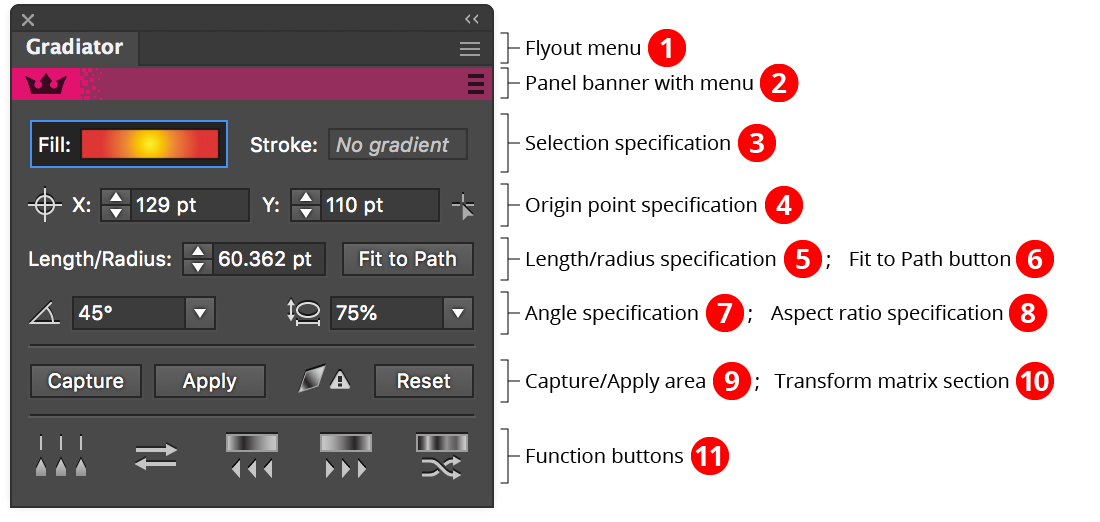
Gradiator Panel Overview
1. Gradiator Panel Flyout Menu
See Gradiator Panel: Flyout Menu.
2. Panel banner
The help button on the right opens the help documentation in the Astute Manager. If this does not automatically appear, please ensure your Astute Manager is running first.
3.4. Selection and Origin Point Specification
See Gradiator Panel: Selection and Origin Point Specification.
5.6.7.8. Length, Angle, Fit and Aspect Ratio Specifications
See Gradiator Panel: Length, Angle, Fit and Aspect Ratio Specifications.
9. Capture/ Apply area
See Gradiator Panel: Capture/ Apply area.
10. Transform Matrix Section
See Gradiator Panel: Transform Matrix Section.
11. Function Buttons
Selection and Origin Point Specification
Selection Specification
Specifies which gradients to operate on: those on the fills of the selected paths, those on the strokes, or both. Clicking on the Fill or Stroke area toggles its selection state. Previews of the gradient present in each area are shown; if multiple, different gradients are selected, the corresponding area will show “Mixed gradients”.
Origin Point Specification
Lets you specify the origin point of the selected gradients either by entering the coordinates numerically, or, after clicking the icon on the right side, by using a tool to click on the artboard to specify the position.
The first time you change the origin point of a linear gradient, Gradiator will display a message reminding you that a linear gradient’s origin is always adjusted by Illustrator so it lies on a line passing through the center of the path’s bounding box (this behavior is also apparent when using the native Gradient tool). You can suppress this message from coming up again by clicking the Don’t show again checkbox. To restore this and other messages and warnings, see Gradiator Panel: Flyout Menu.
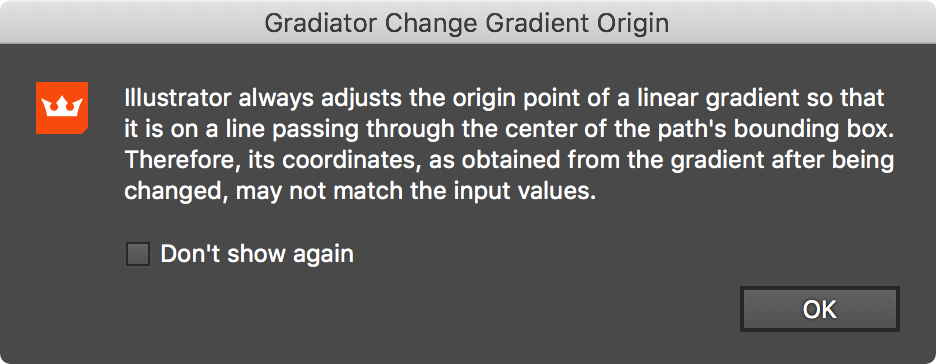
Gradiator Panel Warning Dialog
To center the gradient’s origin, Shift-click the crosshair icon on the left. To set a gradient’s center rather than its origin when clicking with the origin setter tool, hold down Shift before clicking. After clicking, the tool will switch back to the previously-selected tool.
Length, Angle, Fit and Aspect Ratio Specifications
Length/Radius Specification
Allows you to numerically specify the length (for linear gradients) or radius (for radial gradients) of the selected gradients.

Gradiator Panel Change Length Example
By default, the length is adjusted from the origin (i.e., the left side, for linear gradients with no rotation). To adjust the length from the middle of the gradient, enable the preference Adjust Linear Gradient Lengths From Center (see Gradiator Preferences).
Note that Illustrator places lower limits on the length of a gradient. Specifically, it cannot be less than 0.1% of the default (fitted) length. A warning message will be displayed if the gradient length could not be changed to the length specified.
Fit to Path Button
The Fit to Path button resets the length (and origin) of each gradient to the default values that Illustrator assigns whenever the path’s geometry is edited, causing linear gradients to precisely stretch across the entire bounds of the path.

Gradiator Panel Fit to Path Example
For radial gradients, the default fit is more complicated: its radius is set to half the hypotenuse of the bounding box divided by the square root of 2.
Angle Specification
By default, the Gradiator panel angle control is in Absolute mode; i.e., the value you enter becomes the gradient’s new angle (the same as the native Gradient panel). However, either through the preferences or by Option/Alt-clicking on the angle icon, you can change this mode to Relative. In this mode (indicated by a change in icon), the value specified is added to the current angle of each gradient when the now-visible Change button is clicked.
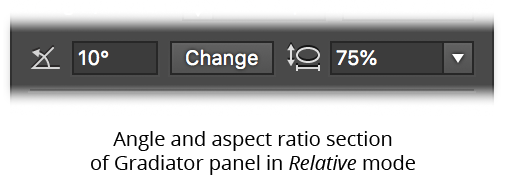
Gradiator Panel Relative Angle Section
Holding Shift when clicking the Change button has the effect of reversing the sign of the angle value (thereby causing the gradient to rotate in the opposite direction).
Aspect Ratio Specification
This control is only enabled when a radial gradient is present in the selection. Unlike the native gradient panel, you can change the aspect ratio of all selected radial gradients even if there are linear gradients also present in the selection.
Capture/Apply Area
Available when a single gradient is selected, the Capture button allows you to effectively take a “snapshot” of the gradient; this snapshot can then subsequently be applied to any other paths, or to the same path after it has been edited. Crucially, the gradient retains its absolute position, allowing you to effortlessly line up a single gradient across several separate paths, or to return a gradient to the position it was in before the path was changed.
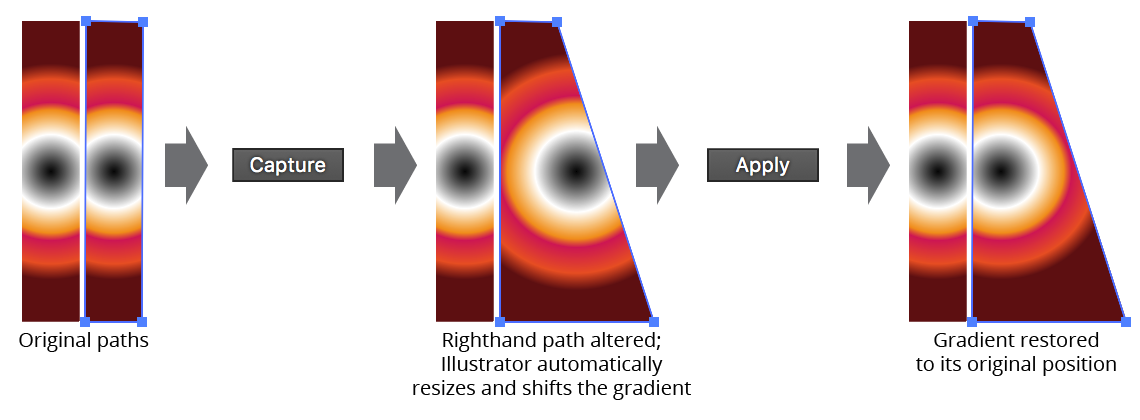
Gradiator Panel Apply Gradient Example
If Shift is held down when the Apply button is clicked, only the captured gradient’s length and origin will be applied to the selected gradients.
Transform Matrix Section
When a path with a gradient fill or stroke is subsequently transformed (scaled, rotated, or sheared), the gradient internally stores this transform using a mathematical construct called a matrix. This can lead to several issues. For example, if the path’s geometry is modified by certain Pathfinder operations, Illustrator resets the transform matrix, causing the gradient’s angle to change. Also, if the transform is non-uniform (caused by shearing or the equivalent rotation plus non-uniform scaling), the numerical values of the gradient’s length, angle and aspect ratio will not always agree with its visual appearance, even though the displayed values are technically correct in a mathematical sense. For these reasons, it is generally preferable to keep artwork free of transform matrices.
The Transform Matrix Alert icon is displayed whenever at least one gradient in the current selection has a transform matrix. Also displayed is the Reset button, which will remove each transform matrix from the selected gradients.
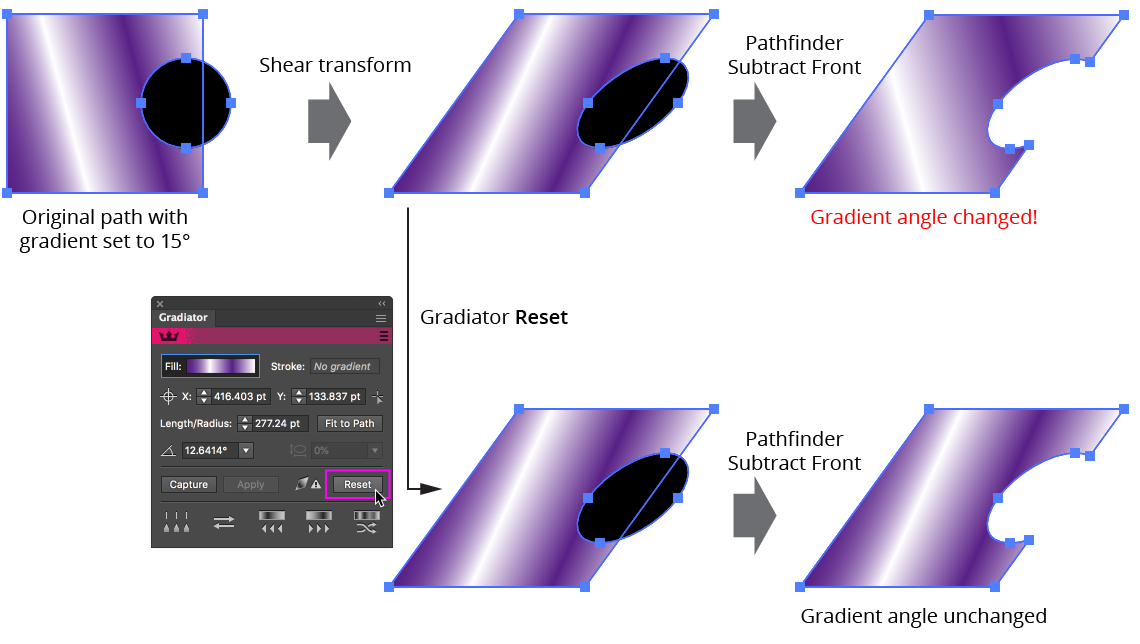
Gradiator Panel Reset Gradient Example
When Reset is used on a linear gradient, the gradient’s position is retained. Unfortunately, this is generally not possible with radial gradients. As a convenience, holding down Shift when clicking the Reset button will also reset the angle to 0°.
Function Buttons
a. Distribute Stops Button: Adjusts the positions of the selected gradients’ stops (except for the first and last) so that there is equal space between them, and sets all midpoints to a location of 50%. To retain the midpoints’ positions, hold Shift when clicking the button. To use an eased distribution, where the space between stops gradually increases or decreases, hold Option/Alt which clicking.
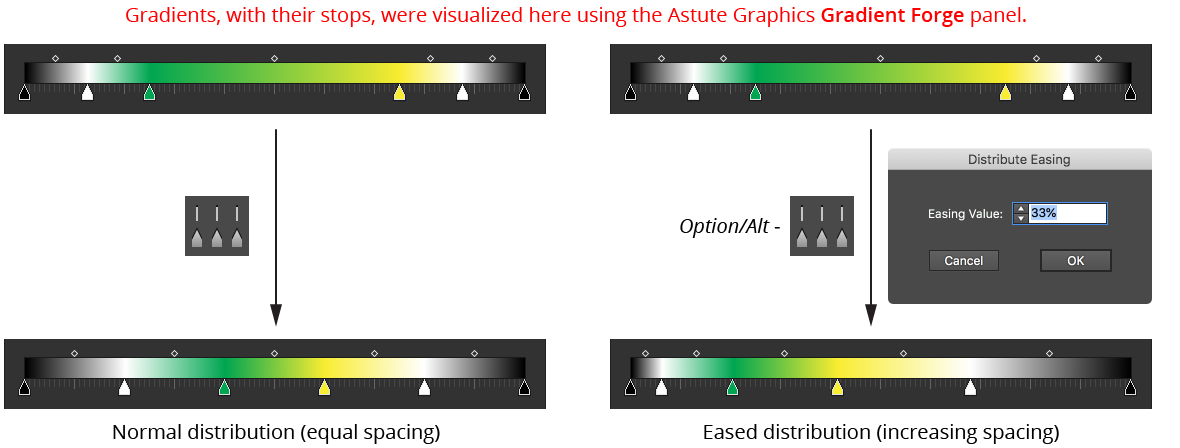
Gradiator Panel Distribute Stops Example
b. Reverse Gradient Button: Reverses the stop positions of the selected gradients. Unlike the native Gradient panel, you can do this even when there is a mix of different gradients selected.

Gradiator Panel Reverse Gradient Example
c. Rotate Colors Left Button: Changes the colors of the selected gradients’ stops so the color of each stop is moved one stop to the left (and the color of the last stop becomes the color of the first stop). This, therefore, has the effect of rotating the colors to the left.
d. Rotate Colors Right Button: Changes the colors of the selected gradients’ stops so the color of each stop is moved one stop to the right (and the color of the first stop becomes the color of the last stop). This, therefore, has the effect of rotating the colors to the right.

Gradiator Panel Rotate Gradient Example
e. Randomize Color Order Button: Randomizes the order of the colors of the selected gradients’ stops. The positions of the stops themselves are not changed. A new random seed is used on each press of the button, which usually results in a different look.

Gradiator Panel Randomize Example
